Reflective Essay on the Impact of Gamification in Travel Apps
VerifiedAdded on 2020/05/08
|6
|1353
|455
Essay
AI Summary
This reflective essay examines the application of gamification within a travel app, "Travel, Explore and Go." The essay explores how gamification techniques, such as rewards and competition, are utilized to motivate user engagement with the app. It discusses the evolution of travel apps and their impact on the tourism industry, highlighting the app's features for interacting with landmarks and local businesses. The essay analyzes the strengths and limitations of gamification, emphasizing its role in customer engagement, marketing campaigns, and the creation of loyalty. It also addresses the app's potential for improving travel experiences and attracting tourists, especially in areas with limited information. The essay concludes by acknowledging gamification as a powerful tool for enhancing customer interactions and driving technological advancements in the digital world. References to relevant research are included to support the analysis.
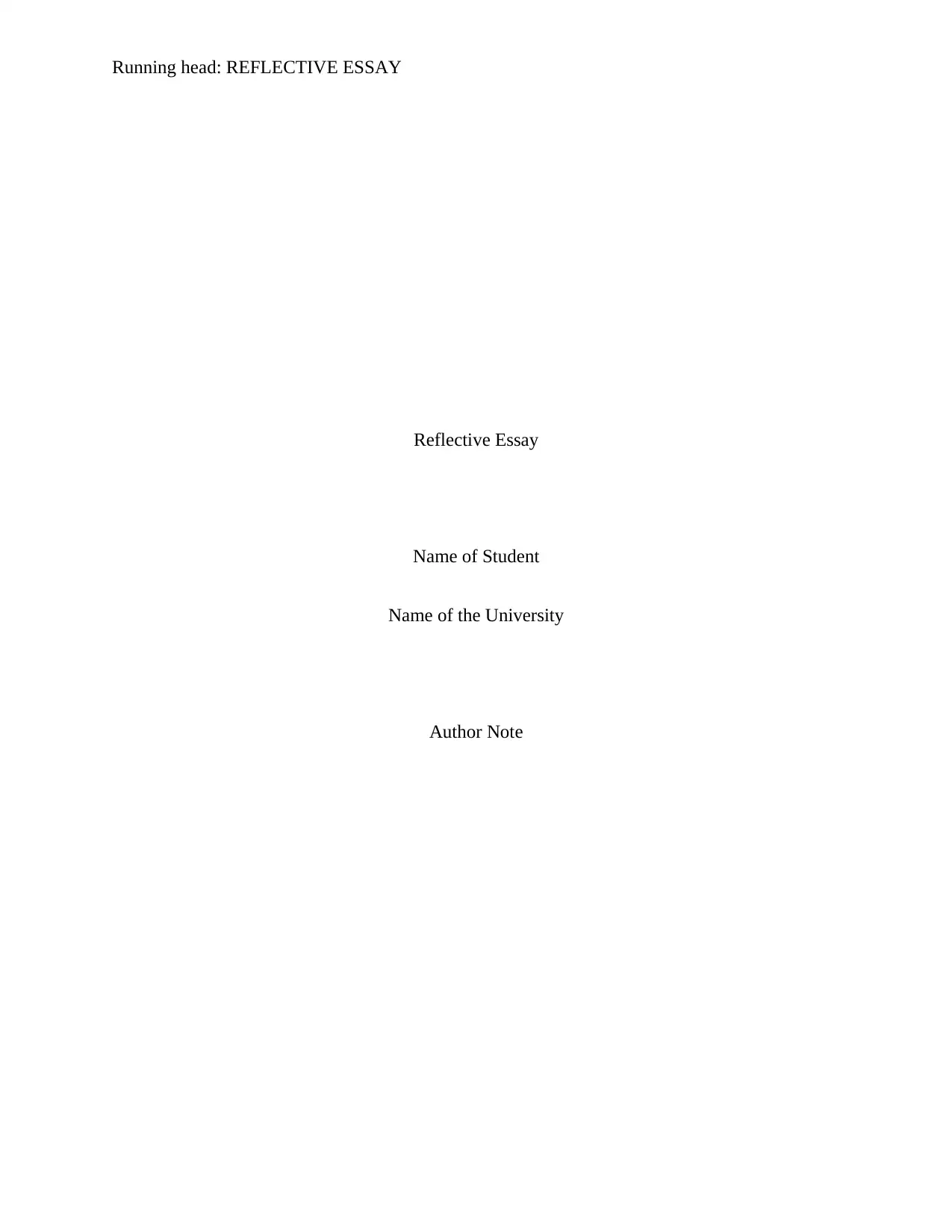
Running head: REFLECTIVE ESSAY
Reflective Essay
Name of Student
Name of the University
Author Note
Reflective Essay
Name of Student
Name of the University
Author Note
Paraphrase This Document
Need a fresh take? Get an instant paraphrase of this document with our AI Paraphraser
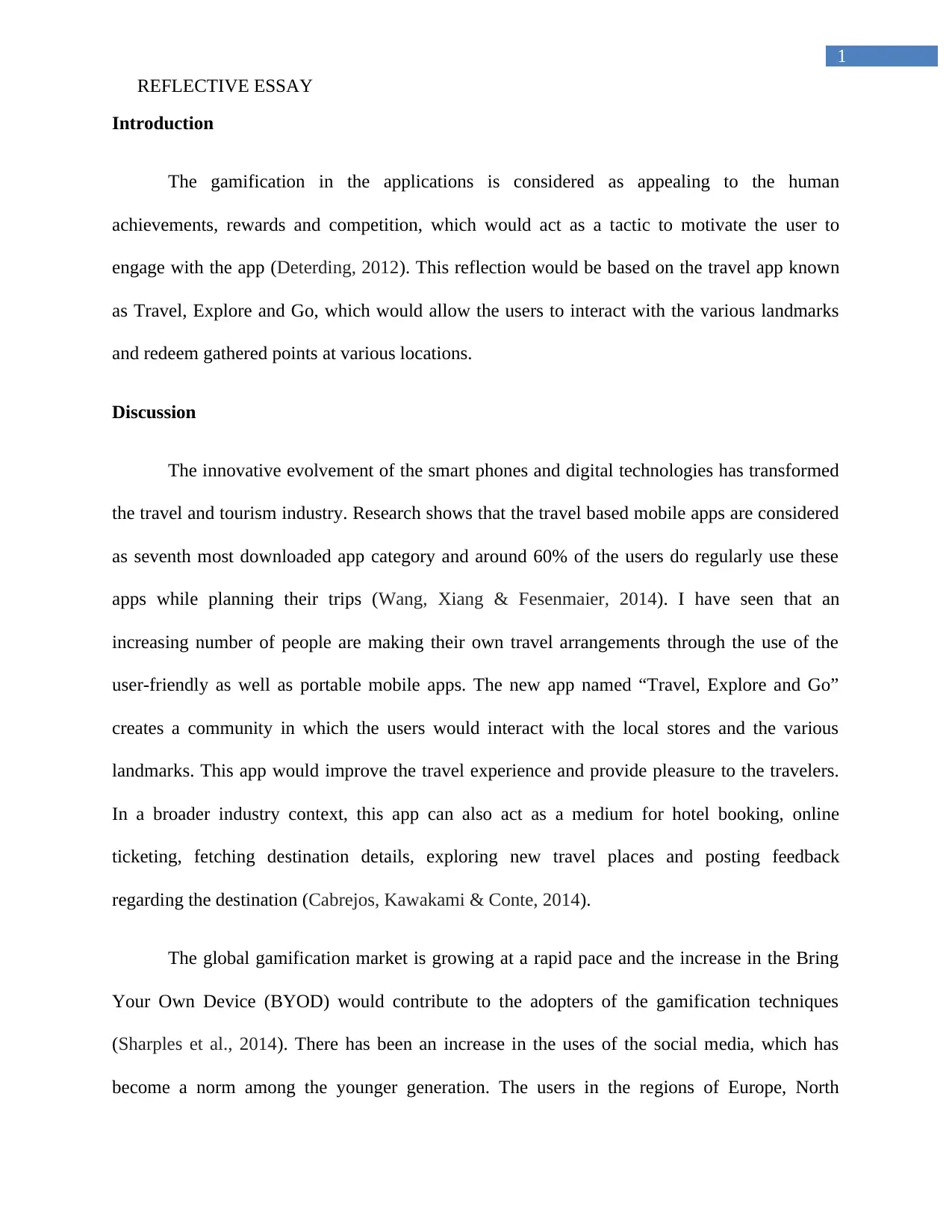
1
REFLECTIVE ESSAY
Introduction
The gamification in the applications is considered as appealing to the human
achievements, rewards and competition, which would act as a tactic to motivate the user to
engage with the app (Deterding, 2012). This reflection would be based on the travel app known
as Travel, Explore and Go, which would allow the users to interact with the various landmarks
and redeem gathered points at various locations.
Discussion
The innovative evolvement of the smart phones and digital technologies has transformed
the travel and tourism industry. Research shows that the travel based mobile apps are considered
as seventh most downloaded app category and around 60% of the users do regularly use these
apps while planning their trips (Wang, Xiang & Fesenmaier, 2014). I have seen that an
increasing number of people are making their own travel arrangements through the use of the
user-friendly as well as portable mobile apps. The new app named “Travel, Explore and Go”
creates a community in which the users would interact with the local stores and the various
landmarks. This app would improve the travel experience and provide pleasure to the travelers.
In a broader industry context, this app can also act as a medium for hotel booking, online
ticketing, fetching destination details, exploring new travel places and posting feedback
regarding the destination (Cabrejos, Kawakami & Conte, 2014).
The global gamification market is growing at a rapid pace and the increase in the Bring
Your Own Device (BYOD) would contribute to the adopters of the gamification techniques
(Sharples et al., 2014). There has been an increase in the uses of the social media, which has
become a norm among the younger generation. The users in the regions of Europe, North
REFLECTIVE ESSAY
Introduction
The gamification in the applications is considered as appealing to the human
achievements, rewards and competition, which would act as a tactic to motivate the user to
engage with the app (Deterding, 2012). This reflection would be based on the travel app known
as Travel, Explore and Go, which would allow the users to interact with the various landmarks
and redeem gathered points at various locations.
Discussion
The innovative evolvement of the smart phones and digital technologies has transformed
the travel and tourism industry. Research shows that the travel based mobile apps are considered
as seventh most downloaded app category and around 60% of the users do regularly use these
apps while planning their trips (Wang, Xiang & Fesenmaier, 2014). I have seen that an
increasing number of people are making their own travel arrangements through the use of the
user-friendly as well as portable mobile apps. The new app named “Travel, Explore and Go”
creates a community in which the users would interact with the local stores and the various
landmarks. This app would improve the travel experience and provide pleasure to the travelers.
In a broader industry context, this app can also act as a medium for hotel booking, online
ticketing, fetching destination details, exploring new travel places and posting feedback
regarding the destination (Cabrejos, Kawakami & Conte, 2014).
The global gamification market is growing at a rapid pace and the increase in the Bring
Your Own Device (BYOD) would contribute to the adopters of the gamification techniques
(Sharples et al., 2014). There has been an increase in the uses of the social media, which has
become a norm among the younger generation. The users in the regions of Europe, North
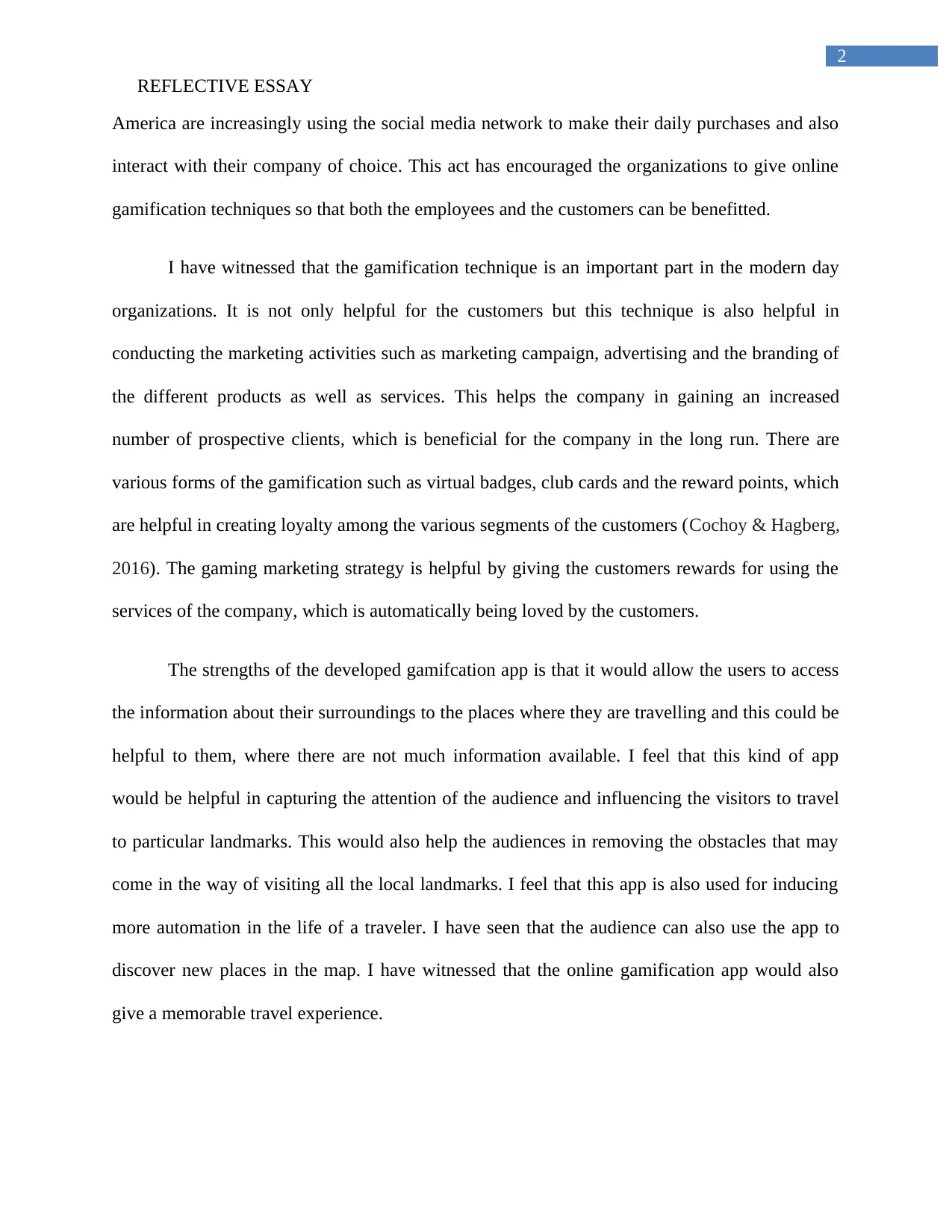
2
REFLECTIVE ESSAY
America are increasingly using the social media network to make their daily purchases and also
interact with their company of choice. This act has encouraged the organizations to give online
gamification techniques so that both the employees and the customers can be benefitted.
I have witnessed that the gamification technique is an important part in the modern day
organizations. It is not only helpful for the customers but this technique is also helpful in
conducting the marketing activities such as marketing campaign, advertising and the branding of
the different products as well as services. This helps the company in gaining an increased
number of prospective clients, which is beneficial for the company in the long run. There are
various forms of the gamification such as virtual badges, club cards and the reward points, which
are helpful in creating loyalty among the various segments of the customers (Cochoy & Hagberg,
2016). The gaming marketing strategy is helpful by giving the customers rewards for using the
services of the company, which is automatically being loved by the customers.
The strengths of the developed gamifcation app is that it would allow the users to access
the information about their surroundings to the places where they are travelling and this could be
helpful to them, where there are not much information available. I feel that this kind of app
would be helpful in capturing the attention of the audience and influencing the visitors to travel
to particular landmarks. This would also help the audiences in removing the obstacles that may
come in the way of visiting all the local landmarks. I feel that this app is also used for inducing
more automation in the life of a traveler. I have seen that the audience can also use the app to
discover new places in the map. I have witnessed that the online gamification app would also
give a memorable travel experience.
REFLECTIVE ESSAY
America are increasingly using the social media network to make their daily purchases and also
interact with their company of choice. This act has encouraged the organizations to give online
gamification techniques so that both the employees and the customers can be benefitted.
I have witnessed that the gamification technique is an important part in the modern day
organizations. It is not only helpful for the customers but this technique is also helpful in
conducting the marketing activities such as marketing campaign, advertising and the branding of
the different products as well as services. This helps the company in gaining an increased
number of prospective clients, which is beneficial for the company in the long run. There are
various forms of the gamification such as virtual badges, club cards and the reward points, which
are helpful in creating loyalty among the various segments of the customers (Cochoy & Hagberg,
2016). The gaming marketing strategy is helpful by giving the customers rewards for using the
services of the company, which is automatically being loved by the customers.
The strengths of the developed gamifcation app is that it would allow the users to access
the information about their surroundings to the places where they are travelling and this could be
helpful to them, where there are not much information available. I feel that this kind of app
would be helpful in capturing the attention of the audience and influencing the visitors to travel
to particular landmarks. This would also help the audiences in removing the obstacles that may
come in the way of visiting all the local landmarks. I feel that this app is also used for inducing
more automation in the life of a traveler. I have seen that the audience can also use the app to
discover new places in the map. I have witnessed that the online gamification app would also
give a memorable travel experience.
⊘ This is a preview!⊘
Do you want full access?
Subscribe today to unlock all pages.

Trusted by 1+ million students worldwide
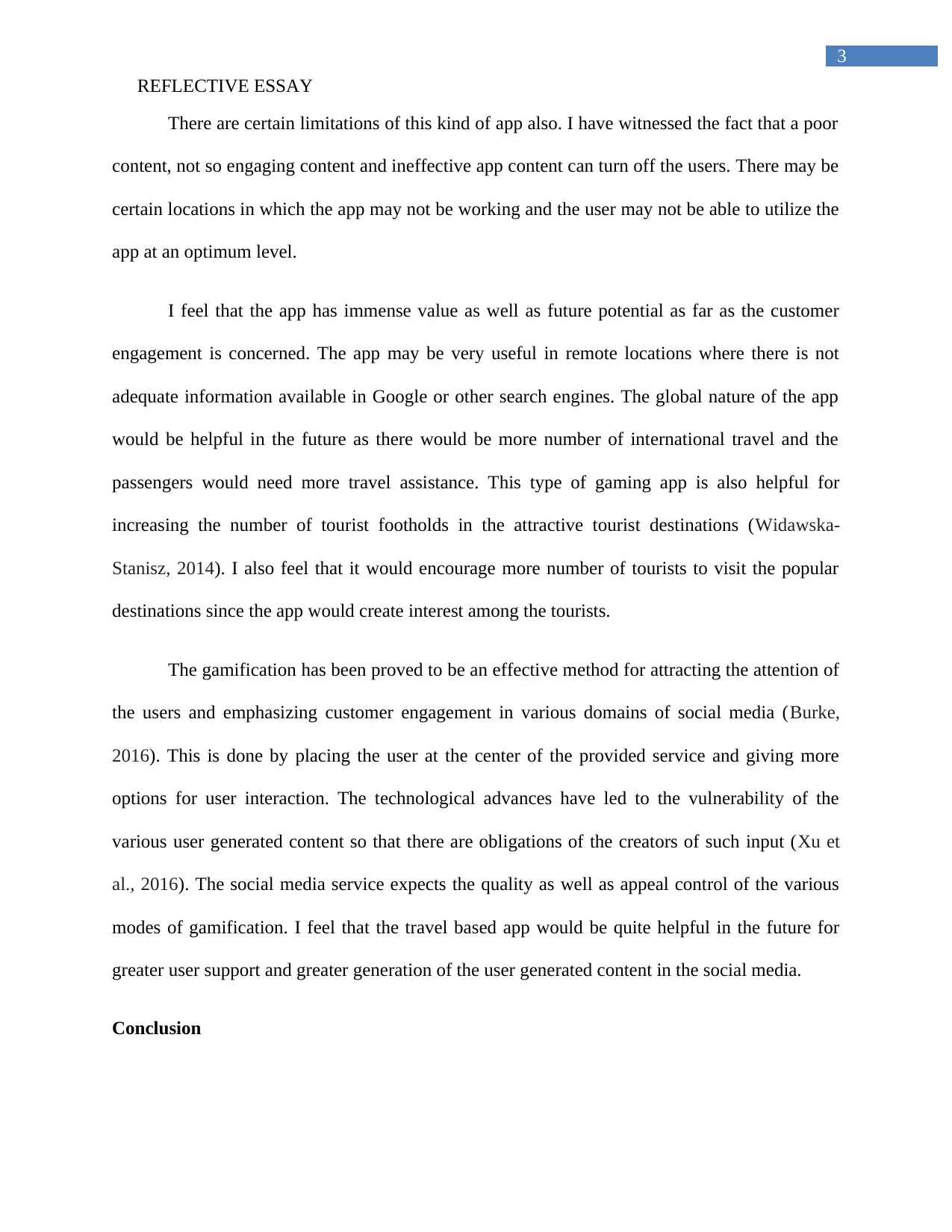
3
REFLECTIVE ESSAY
There are certain limitations of this kind of app also. I have witnessed the fact that a poor
content, not so engaging content and ineffective app content can turn off the users. There may be
certain locations in which the app may not be working and the user may not be able to utilize the
app at an optimum level.
I feel that the app has immense value as well as future potential as far as the customer
engagement is concerned. The app may be very useful in remote locations where there is not
adequate information available in Google or other search engines. The global nature of the app
would be helpful in the future as there would be more number of international travel and the
passengers would need more travel assistance. This type of gaming app is also helpful for
increasing the number of tourist footholds in the attractive tourist destinations (Widawska-
Stanisz, 2014). I also feel that it would encourage more number of tourists to visit the popular
destinations since the app would create interest among the tourists.
The gamification has been proved to be an effective method for attracting the attention of
the users and emphasizing customer engagement in various domains of social media (Burke,
2016). This is done by placing the user at the center of the provided service and giving more
options for user interaction. The technological advances have led to the vulnerability of the
various user generated content so that there are obligations of the creators of such input (Xu et
al., 2016). The social media service expects the quality as well as appeal control of the various
modes of gamification. I feel that the travel based app would be quite helpful in the future for
greater user support and greater generation of the user generated content in the social media.
Conclusion
REFLECTIVE ESSAY
There are certain limitations of this kind of app also. I have witnessed the fact that a poor
content, not so engaging content and ineffective app content can turn off the users. There may be
certain locations in which the app may not be working and the user may not be able to utilize the
app at an optimum level.
I feel that the app has immense value as well as future potential as far as the customer
engagement is concerned. The app may be very useful in remote locations where there is not
adequate information available in Google or other search engines. The global nature of the app
would be helpful in the future as there would be more number of international travel and the
passengers would need more travel assistance. This type of gaming app is also helpful for
increasing the number of tourist footholds in the attractive tourist destinations (Widawska-
Stanisz, 2014). I also feel that it would encourage more number of tourists to visit the popular
destinations since the app would create interest among the tourists.
The gamification has been proved to be an effective method for attracting the attention of
the users and emphasizing customer engagement in various domains of social media (Burke,
2016). This is done by placing the user at the center of the provided service and giving more
options for user interaction. The technological advances have led to the vulnerability of the
various user generated content so that there are obligations of the creators of such input (Xu et
al., 2016). The social media service expects the quality as well as appeal control of the various
modes of gamification. I feel that the travel based app would be quite helpful in the future for
greater user support and greater generation of the user generated content in the social media.
Conclusion
Paraphrase This Document
Need a fresh take? Get an instant paraphrase of this document with our AI Paraphraser
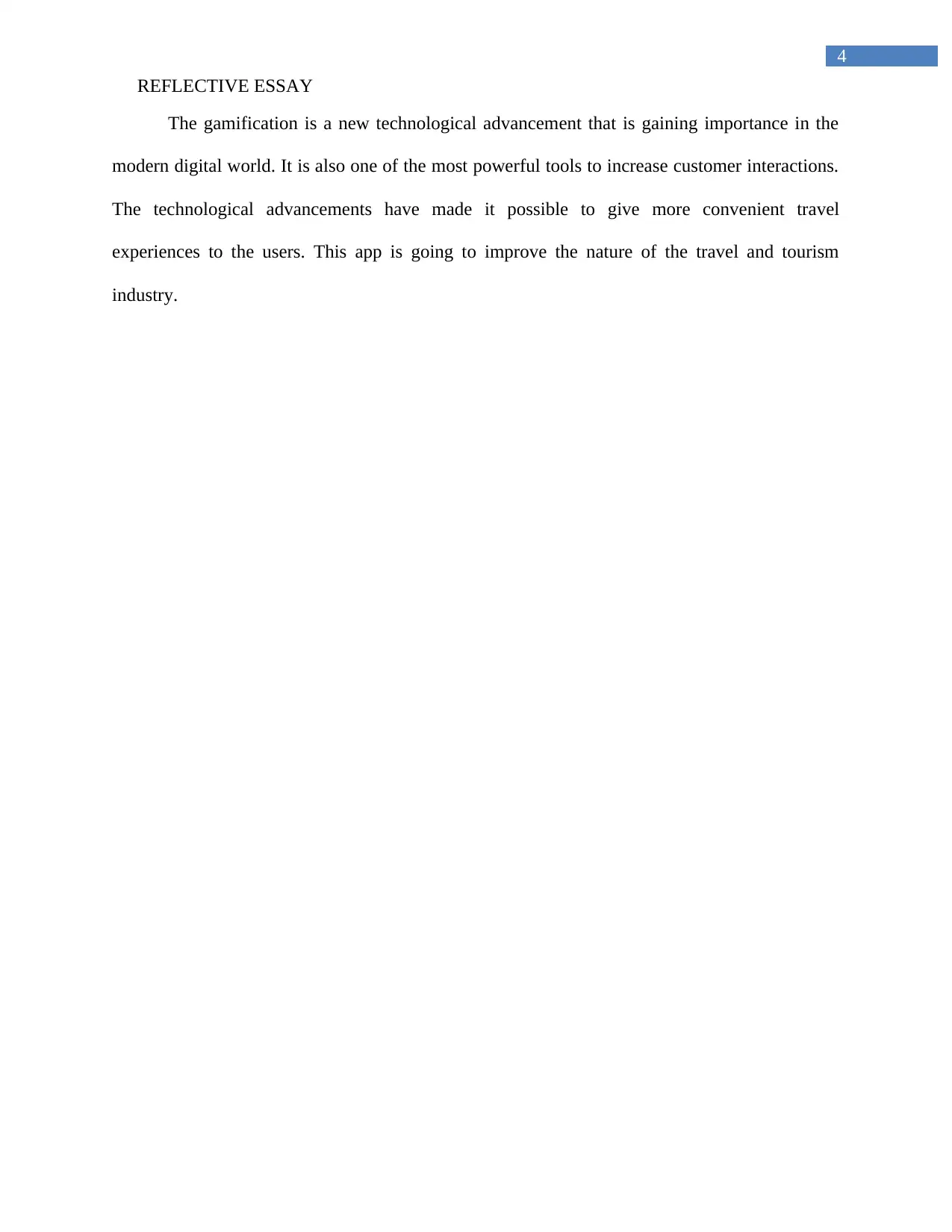
4
REFLECTIVE ESSAY
The gamification is a new technological advancement that is gaining importance in the
modern digital world. It is also one of the most powerful tools to increase customer interactions.
The technological advancements have made it possible to give more convenient travel
experiences to the users. This app is going to improve the nature of the travel and tourism
industry.
REFLECTIVE ESSAY
The gamification is a new technological advancement that is gaining importance in the
modern digital world. It is also one of the most powerful tools to increase customer interactions.
The technological advancements have made it possible to give more convenient travel
experiences to the users. This app is going to improve the nature of the travel and tourism
industry.
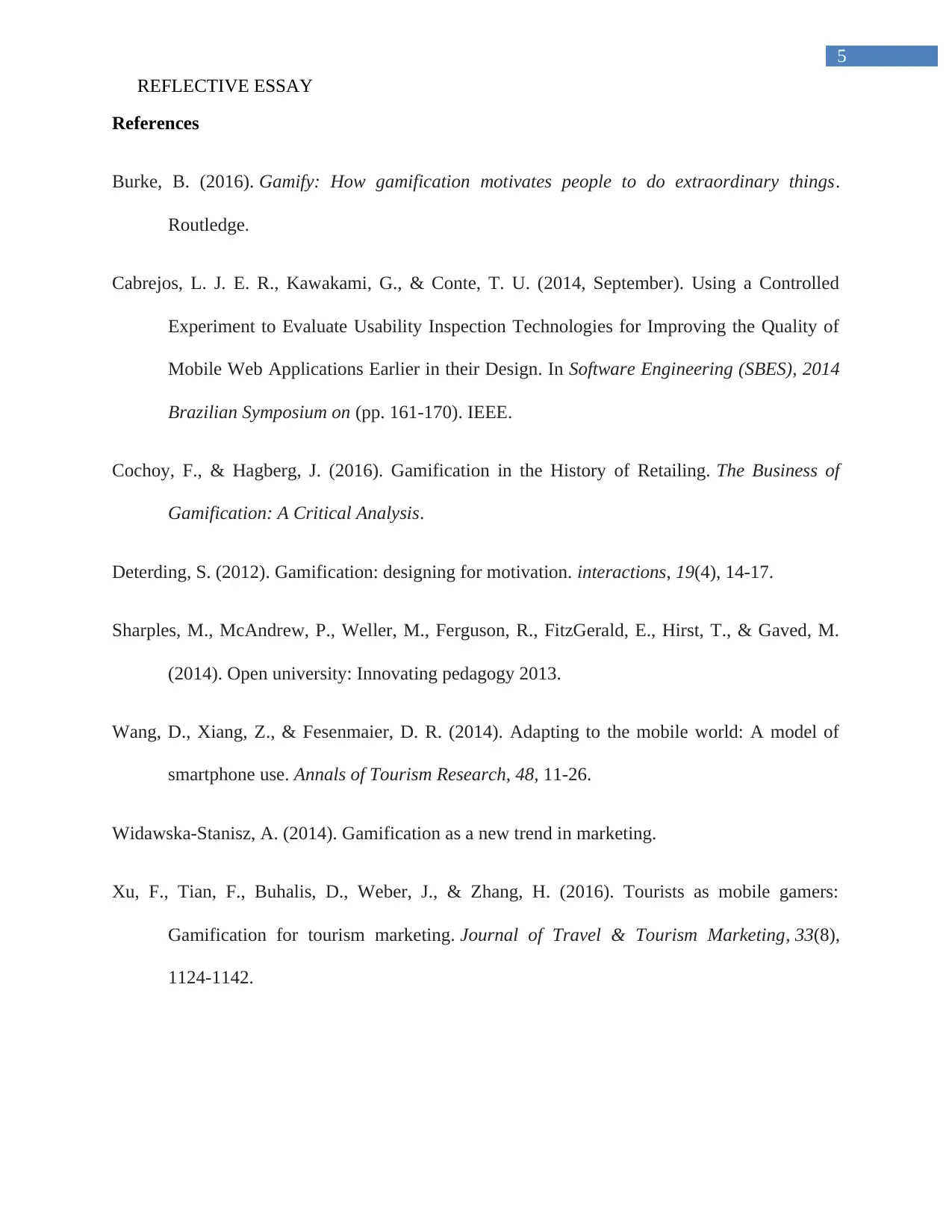
5
REFLECTIVE ESSAY
References
Burke, B. (2016). Gamify: How gamification motivates people to do extraordinary things.
Routledge.
Cabrejos, L. J. E. R., Kawakami, G., & Conte, T. U. (2014, September). Using a Controlled
Experiment to Evaluate Usability Inspection Technologies for Improving the Quality of
Mobile Web Applications Earlier in their Design. In Software Engineering (SBES), 2014
Brazilian Symposium on (pp. 161-170). IEEE.
Cochoy, F., & Hagberg, J. (2016). Gamification in the History of Retailing. The Business of
Gamification: A Critical Analysis.
Deterding, S. (2012). Gamification: designing for motivation. interactions, 19(4), 14-17.
Sharples, M., McAndrew, P., Weller, M., Ferguson, R., FitzGerald, E., Hirst, T., & Gaved, M.
(2014). Open university: Innovating pedagogy 2013.
Wang, D., Xiang, Z., & Fesenmaier, D. R. (2014). Adapting to the mobile world: A model of
smartphone use. Annals of Tourism Research, 48, 11-26.
Widawska-Stanisz, A. (2014). Gamification as a new trend in marketing.
Xu, F., Tian, F., Buhalis, D., Weber, J., & Zhang, H. (2016). Tourists as mobile gamers:
Gamification for tourism marketing. Journal of Travel & Tourism Marketing, 33(8),
1124-1142.
REFLECTIVE ESSAY
References
Burke, B. (2016). Gamify: How gamification motivates people to do extraordinary things.
Routledge.
Cabrejos, L. J. E. R., Kawakami, G., & Conte, T. U. (2014, September). Using a Controlled
Experiment to Evaluate Usability Inspection Technologies for Improving the Quality of
Mobile Web Applications Earlier in their Design. In Software Engineering (SBES), 2014
Brazilian Symposium on (pp. 161-170). IEEE.
Cochoy, F., & Hagberg, J. (2016). Gamification in the History of Retailing. The Business of
Gamification: A Critical Analysis.
Deterding, S. (2012). Gamification: designing for motivation. interactions, 19(4), 14-17.
Sharples, M., McAndrew, P., Weller, M., Ferguson, R., FitzGerald, E., Hirst, T., & Gaved, M.
(2014). Open university: Innovating pedagogy 2013.
Wang, D., Xiang, Z., & Fesenmaier, D. R. (2014). Adapting to the mobile world: A model of
smartphone use. Annals of Tourism Research, 48, 11-26.
Widawska-Stanisz, A. (2014). Gamification as a new trend in marketing.
Xu, F., Tian, F., Buhalis, D., Weber, J., & Zhang, H. (2016). Tourists as mobile gamers:
Gamification for tourism marketing. Journal of Travel & Tourism Marketing, 33(8),
1124-1142.
⊘ This is a preview!⊘
Do you want full access?
Subscribe today to unlock all pages.

Trusted by 1+ million students worldwide
1 out of 6
Related Documents
Your All-in-One AI-Powered Toolkit for Academic Success.
+13062052269
info@desklib.com
Available 24*7 on WhatsApp / Email
![[object Object]](/_next/static/media/star-bottom.7253800d.svg)
Unlock your academic potential
Copyright © 2020–2025 A2Z Services. All Rights Reserved. Developed and managed by ZUCOL.




